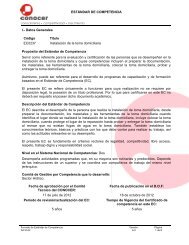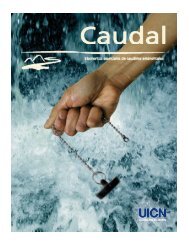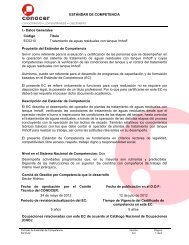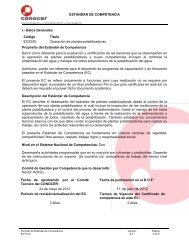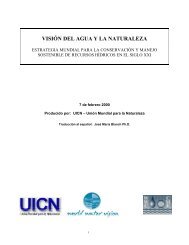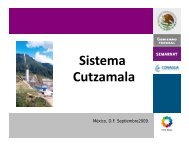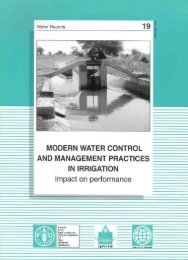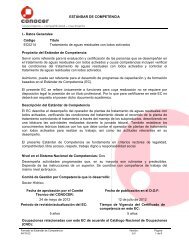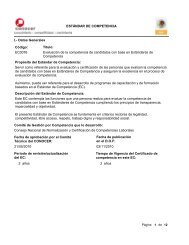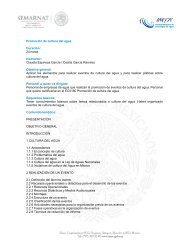Agricultural drainage water management in arid and semi ... - FAO.org
Agricultural drainage water management in arid and semi ... - FAO.org
Agricultural drainage water management in arid and semi ... - FAO.org
You also want an ePaper? Increase the reach of your titles
YUMPU automatically turns print PDFs into web optimized ePapers that Google loves.
iiiForewordIrrigated agriculture has made a significant contribution towards world food security. However,<strong>water</strong> resources for agriculture are often overused <strong>and</strong> misused. The result has been large-scale<strong>water</strong>logg<strong>in</strong>g <strong>and</strong> sal<strong>in</strong>ity. In addition, downstream users have found themselves deprived ofsufficient <strong>water</strong>, <strong>and</strong> there has been much pollution of fresh<strong>water</strong> resources with contam<strong>in</strong>atedirrigation return flows <strong>and</strong> deep percolation losses. Irrigated agriculture needs to exp<strong>and</strong> <strong>in</strong>order to produce sufficient food for the world’s grow<strong>in</strong>g population. The productivity of <strong>water</strong>use <strong>in</strong> agriculture needs to <strong>in</strong>crease <strong>in</strong> order both to avoid exacerbat<strong>in</strong>g the <strong>water</strong> crisis <strong>and</strong> toprevent considerable food shortages. As irrigated agriculture requires <strong>dra<strong>in</strong>age</strong>, a major challengeis to manage agricultural <strong>dra<strong>in</strong>age</strong> <strong>water</strong> <strong>in</strong> a susta<strong>in</strong>able manner.Up until about 20 years ago, there were few or <strong>in</strong>deed no constra<strong>in</strong>ts on the disposal of <strong>dra<strong>in</strong>age</strong><strong>water</strong> from irrigated l<strong>and</strong>s. One of the pr<strong>in</strong>ciple reasons for <strong>in</strong>creased constra<strong>in</strong>ts on <strong>dra<strong>in</strong>age</strong>disposal is to protect the quality of receiv<strong>in</strong>g <strong>water</strong>s for downstream uses <strong>and</strong> to protect theregional environment <strong>and</strong> ecology. Many developed <strong>and</strong> develop<strong>in</strong>g countries practise <strong>dra<strong>in</strong>age</strong><strong>water</strong> <strong>management</strong>. This study has brought together case studies on agricultural <strong>dra<strong>in</strong>age</strong> <strong>water</strong><strong>management</strong> from the United States of America, Central Asia, Egypt, India <strong>and</strong> Pakistan <strong>in</strong>order to learn from their experiences <strong>and</strong> to enable the formulation of guidel<strong>in</strong>es on <strong>dra<strong>in</strong>age</strong><strong>water</strong> <strong>management</strong>. From the case studies, it was possible to dist<strong>in</strong>guish four broad groups of<strong>dra<strong>in</strong>age</strong> <strong>water</strong> <strong>management</strong> options: <strong>water</strong> conservation, <strong>dra<strong>in</strong>age</strong> <strong>water</strong> reuse, <strong>dra<strong>in</strong>age</strong> <strong>water</strong>disposal <strong>and</strong> <strong>dra<strong>in</strong>age</strong> <strong>water</strong> treatment. Each of these options has certa<strong>in</strong> potential impacts onthe hydrology <strong>and</strong> <strong>water</strong> quality <strong>in</strong> an area. Interactions <strong>and</strong> trade-offs occur when more thanone option is applied.Planners, decision-makers <strong>and</strong> eng<strong>in</strong>eers need a framework <strong>in</strong> order to help them to select fromamong the various options <strong>and</strong> to evaluate their impact <strong>and</strong> contribution towards developmentgoals. Moreover, technical expertise <strong>and</strong> guidel<strong>in</strong>es on each of the options are required toenable improved assessment of the impact of the different options <strong>and</strong> to facilitate the preparationof <strong>dra<strong>in</strong>age</strong> <strong>water</strong> <strong>management</strong> plans <strong>and</strong> designs. The <strong>in</strong>tention of this publication is to provideguidel<strong>in</strong>es to susta<strong>in</strong> irrigated agriculture <strong>and</strong> at the same time to protect <strong>water</strong> resources fromthe negative impacts of agricultural <strong>dra<strong>in</strong>age</strong> <strong>water</strong> disposal.This publication consists of two parts. Part I deals with the underly<strong>in</strong>g concepts relat<strong>in</strong>g to<strong>dra<strong>in</strong>age</strong> <strong>water</strong> <strong>management</strong>. It discusses the adequate identification <strong>and</strong> def<strong>in</strong>ition of the problemfor the selection <strong>and</strong> application of a comb<strong>in</strong>ation of <strong>management</strong> options. It then presentstechnical considerations <strong>and</strong> details on the four groups of <strong>dra<strong>in</strong>age</strong> <strong>management</strong> options. Part IIconta<strong>in</strong>s the summaries of the case studies from the United States of America, Central Asia,Egypt, India <strong>and</strong> Pakistan. These case studies represent a cross-section of approaches toagricultural <strong>dra<strong>in</strong>age</strong> <strong>water</strong> <strong>management</strong>. The factors affect<strong>in</strong>g <strong>dra<strong>in</strong>age</strong> <strong>water</strong> <strong>management</strong><strong>in</strong>clude geomorphology, hydrology, climate conditions <strong>and</strong> the socio-economic <strong>and</strong> <strong>in</strong>stitutionalenvironment. The full texts of the case studies can be found on the attached CD-ROM.



